Induction of cell scattering by expression of beta1 integrins in beta1-deficient epithelial cells requires activation of members of the rho family of GTPases and downregulation of cadherin and catenin function
- PMID: 10601344
- PMCID: PMC2168093
- DOI: 10.1083/jcb.147.6.1325
Induction of cell scattering by expression of beta1 integrins in beta1-deficient epithelial cells requires activation of members of the rho family of GTPases and downregulation of cadherin and catenin function
Abstract
Adhesion receptors, which connect cells to each other and to the surrounding extracellular matrix (ECM), play a crucial role in the control of tissue structure and of morphogenesis. In this work, we have studied how intercellular adhesion molecules and beta1 integrins influence each other using two different beta1-null cell lines, epithelial GE11 and fibroblast-like GD25 cells. Expression of beta1A or the cytoplasmic splice variant beta1D, induced the disruption of intercellular adherens junctions and cell scattering in both GE11 and GD25 cells. In GE11 cells, the morphological change correlated with the redistribution of zonula occluden (ZO)-1 from tight junctions to adherens junctions at high cell confluency. In addition, the expression of beta1 integrins caused a dramatic reorganization of the actin cytoskeleton and of focal contacts. Interaction of beta1 integrins with their respective ligands was required for a complete morphological transition towards the spindle-shaped fibroblast-like phenotype. The expression of an interleukin-2 receptor (IL2R)-beta1A chimera and its incorporation into focal adhesions also induced the disruption of cadherin-based adhesions and the reorganization of ECM-cell contacts, but failed to promote cell migration on fibronectin, in contrast to full-length beta1A. This indicates that the disruption of cell-cell adhesion is not simply the consequence of the stimulated cell migration. Expression of beta1 integrins in GE11 cells resulted in a decrease in cadherin and alpha-catenin protein levels accompanied by their redistribution from the cytoskeleton-associated fraction to the detergent-soluble fraction. Regulation of alpha-catenin protein levels by beta1 integrins is likely to play a role in the morphological transition, since overexpression of alpha-catenin in GE11 cells before beta1 prevented the disruption of intercellular adhesions and cell scattering. In addition, using biochemical activity assays for Rho-like GTPases, we show that the expression of beta1A, beta1D, or IL2R-beta1A in GE11 or GD25 cells triggers activation of both RhoA and Rac1, but not of Cdc42. Moreover, dominant negative Rac1 (N17Rac1) inhibited the disruption of cell-cell adhesions when expressed before beta1. However, all three GTPases might be involved in the morphological transition, since expression of either N19RhoA, N17Rac1, or N17Cdc42 reversed cell scattering and partially restored cadherin-based adhesions in GE11-beta1A cells. Our results indicate that beta1 integrins regulate the polarity and motility of epithelial cells by the induction of intracellular molecular events involving a downregulation of alpha-catenin function and the activation of the Rho-like G proteins Rac1 and RhoA.
Figures

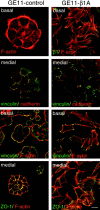
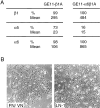
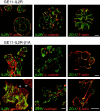
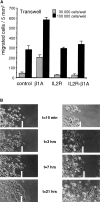

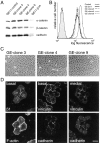

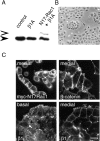
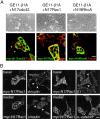
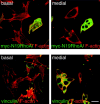
Similar articles
-
Temporal and spatial modulation of Rho GTPases during in vitro formation of capillary vascular network. Adherens junctions and myosin light chain as targets of Rac1 and RhoA.J Biol Chem. 2003 Dec 12;278(50):50702-13. doi: 10.1074/jbc.M307234200. Epub 2003 Sep 12. J Biol Chem. 2003. PMID: 12972426
-
RhoA, Rac1, and Cdc42 exert distinct effects on epithelial barrier via selective structural and biochemical modulation of junctional proteins and F-actin.Am J Physiol Cell Physiol. 2004 Aug;287(2):C327-35. doi: 10.1152/ajpcell.00087.2004. Epub 2004 Mar 24. Am J Physiol Cell Physiol. 2004. PMID: 15044152
-
p120 catenin regulates the actin cytoskeleton via Rho family GTPases.J Cell Biol. 2000 Aug 7;150(3):567-80. doi: 10.1083/jcb.150.3.567. J Cell Biol. 2000. PMID: 10931868 Free PMC article.
-
Regulation of Rho family GTPases by cell-cell and cell-matrix adhesion.Biol Res. 2002;35(2):239-46. doi: 10.4067/s0716-97602002000200016. Biol Res. 2002. PMID: 12415742 Review.
-
Rho-family GTPases in cadherin-mediated cell-cell adhesion.Nat Rev Mol Cell Biol. 2001 Dec;2(12):887-97. doi: 10.1038/35103068. Nat Rev Mol Cell Biol. 2001. PMID: 11733768 Review.
Cited by
-
Different splice variants of filamin-B affect myogenesis, subcellular distribution, and determine binding to integrin [beta] subunits.J Cell Biol. 2002 Jan 21;156(2):361-76. doi: 10.1083/jcb.200103037. Epub 2002 Jan 21. J Cell Biol. 2002. PMID: 11807098 Free PMC article.
-
Stromal cells and integrins: conforming to the needs of the tumor microenvironment.Neoplasia. 2009 Dec;11(12):1264-71. doi: 10.1593/neo.91302. Neoplasia. 2009. PMID: 20019834 Free PMC article. Review.
-
Intestinal epithelial CD98: an oligomeric and multifunctional protein.Biochim Biophys Acta. 2008 Oct;1780(10):1087-92. doi: 10.1016/j.bbagen.2008.06.007. Epub 2008 Jun 24. Biochim Biophys Acta. 2008. PMID: 18625289 Free PMC article. Review.
-
Novel kelch-like protein, KLEIP, is involved in actin assembly at cell-cell contact sites of Madin-Darby canine kidney cells.Mol Biol Cell. 2004 Mar;15(3):1172-84. doi: 10.1091/mbc.e03-07-0531. Epub 2003 Dec 10. Mol Biol Cell. 2004. PMID: 14668487 Free PMC article.
-
TGF-beta3-induced palatogenesis requires matrix metalloproteinases.Mol Biol Cell. 2001 May;12(5):1457-66. doi: 10.1091/mbc.12.5.1457. Mol Biol Cell. 2001. PMID: 11359935 Free PMC article.
References
-
- Akiyama S.K., Yamada S.S., Yamada K.M., LaFlamme S.E. Transmembrane signal transduction by integrin cytoplasmic domains expressed in single-subunit chimeras. J. Biol.Chem. 1994;269:15961–15964. - PubMed
-
- Barry S.T., Flinn H.M., Humphries M.J., Critchley D.R., Ridley A.J. Requirement for rho in integrin signaling. Cell Adhes. Commun. 1997;4:387–398. - PubMed
Publication types
MeSH terms
Substances
LinkOut - more resources
Full Text Sources
Research Materials
Miscellaneous

